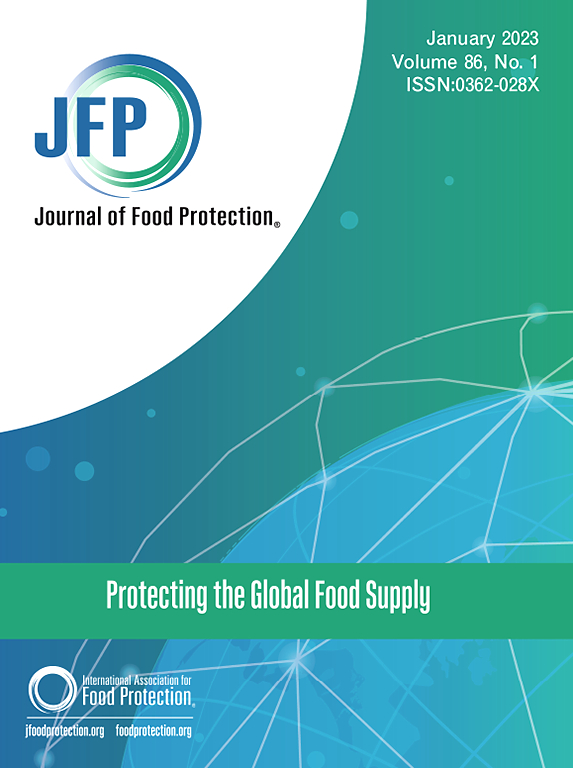预包装冷冻蔬菜的制备方法和食源性疾病的感知风险——美国,2022年9月。
IF 2.1
4区 农林科学
Q3 BIOTECHNOLOGY & APPLIED MICROBIOLOGY
引用次数: 0
摘要
单核细胞增生李斯特菌引起李斯特菌病,这是一种严重的感染,李斯特菌病高风险人群的死亡率很高。第一次与冷冻蔬菜有关的李斯特菌爆发发生在2016年,导致三人死亡。许多冷冻蔬菜是在烹饪后食用的。然而,关于消费者行为的数据很少。我们描述了消费者对预包装冷冻蔬菜污染的看法,以及预包装冷冻蔬菜的制备方法,以帮助告知预防策略。在2022年9月1日至24日期间,波特Novelli公共服务公司使用益普索知识面板进行了秋季风格调查。数据经过加权以代表美国人口。计算点估计值和95% ci,并使用Wald卡方检验确定受访者之间的差异。在报告冷冻蔬菜制备和食用方法的3,008名受访者中,8.7% (95% CI = 7.4%-10.0%)报告曾生吃该产品。有孩子的受访者本文章由计算机程序翻译,如有差异,请以英文原文为准。
Preparation Methods and Perceived Risk of Foodborne Illness Among Consumers of Prepackaged Frozen Vegetables – United States, September 2022
Listeria monocytogenes causes listeriosis, a serious infection with a high mortality rate for persons at higher risk for listeriosis. The first Listeria outbreak linked to frozen vegetables occurred in 2016 and resulted in three deaths. Many frozen vegetables are intended to be consumed after cooking. However, data on consumer behavior are sparse. We characterized consumers’ perceptions of contamination of prepackaged frozen vegetables, and preparation methods of prepackaged frozen vegetables to help inform prevention strategies. During September 1–24, 2022, Porter Novelli Public Services conducted the FallStyles survey using the Ipsos KnowledgePanel. Data were weighted to be representative of the U.S. population. Point estimates and 95% CIs were calculated, and differences between respondents were determined using Wald chi square tests. Among 3,008 respondents reporting a preparation and consumption method for frozen vegetables, 8.7% (95% CI = 7.4–10.0%) reported ever consuming the product raw. Respondents who reported having children < 18 years old were more likely to report ever consuming frozen vegetables raw compared with respondents who did not (12.5% vs. 7.4%, p < 0.01). The most reported raw preparation method was adding them directly to a blender for smoothie or juice (5.6%; 95% CI = 4.6–6.7%). Among respondents who reported eating frozen vegetables, 59.6% (95% CI = 57.6–61.6%) reported following package instructions. A third (34.1% [95% CI = 32.2–35.9%]) of respondents agreed that frozen vegetables can be contaminated with germs (like Salmonella, E. coli, and Listeria), with a greater proportion of people with cancer disagreeing compared to those without cancer (32.5% vs 23.4%, p = 0.041). These findings show that some consumers may not be cooking frozen vegetables before eating them. Second, consumers might not be reading instructions on packaging. Both findings highlight the critical importance of preventive controls in the production of frozen vegetables prior to reaching the consumer.
求助全文
通过发布文献求助,成功后即可免费获取论文全文。
去求助
来源期刊

Journal of food protection
工程技术-生物工程与应用微生物
CiteScore
4.20
自引率
5.00%
发文量
296
审稿时长
2.5 months
期刊介绍:
The Journal of Food Protection® (JFP) is an international, monthly scientific journal in the English language published by the International Association for Food Protection (IAFP). JFP publishes research and review articles on all aspects of food protection and safety. Major emphases of JFP are placed on studies dealing with:
Tracking, detecting (including traditional, molecular, and real-time), inactivating, and controlling food-related hazards, including microorganisms (including antibiotic resistance), microbial (mycotoxins, seafood toxins) and non-microbial toxins (heavy metals, pesticides, veterinary drug residues, migrants from food packaging, and processing contaminants), allergens and pests (insects, rodents) in human food, pet food and animal feed throughout the food chain;
Microbiological food quality and traditional/novel methods to assay microbiological food quality;
Prevention of food-related hazards and food spoilage through food preservatives and thermal/non-thermal processes, including process validation;
Food fermentations and food-related probiotics;
Safe food handling practices during pre-harvest, harvest, post-harvest, distribution and consumption, including food safety education for retailers, foodservice, and consumers;
Risk assessments for food-related hazards;
Economic impact of food-related hazards, foodborne illness, food loss, food spoilage, and adulterated foods;
Food fraud, food authentication, food defense, and foodborne disease outbreak investigations.
 求助内容:
求助内容: 应助结果提醒方式:
应助结果提醒方式:


